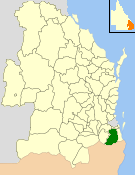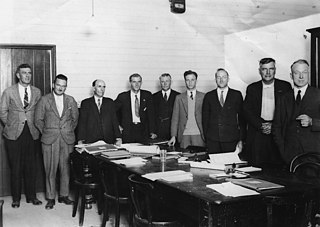The Coolangatta Chronicle was a weekly newspaper printed and published between 1924 and 1927 by Crampton and Co. in Maclean Street Coolangatta, Queensland, Australia, on the border of Tweed Heads, New South Wales. [1] It was one of the early, but short lived, publications written for the residents of the region that would later be known as the Gold Coast, Queensland.
The Coolangatta Chronicle was started by George Stradford Crampton and William Francis Higgins in early 1924. [2] Both men had previous experience in the newspaper industry from outside the region. For the first three months the Coolangatta Chronicle was a free paper that was supported by advertising but from 7 July 1924 readers were charged a penny to buy the publication. [3] [4] In 1926 Crampton sold his interest in the newspaper and left the region to take up a position at the Brisbane Telegraph. [5] [6] [7]
On 8 September 1926 the publication was formally acquired in its entirety by Crampton's business partner, Higgins, who had been involved in newspapers in the Dalby region. [8] [9] In 1927 the Coolangatta Chronicle was purchased by the Tweed Heads and Coolangatta Newspapers Ltd and was amalgamated with the Tweed Heads and Coolangatta Star, which was in its thirteenth year of operation.
The newly united publications underwent a name change and became the Border Star, which was issued twice a week. [10] Higgins, the sole proprietor of the Coolangatta Chronicle became the managing editor of the newly amalgamated publication while W. A. Morley of Tweed Heads was the chairman. [11]
The paper has been partially digitised as part of the Australian Newspapers Digitisation Program of the National Library of Australia. [12]

The Gold Coast, often referred to by its initials G.C., and officially the City of Gold Coast, is Australia’s sixth-largest city, the most populous non-capital city in the Australian state of Queensland, and the state's second-largest city after Brisbane, with a population over 600,000. The Gold Coast is a coastal city and region located approximately 66 kilometres (41 mi) south-southeast of the centre of the state capital, Brisbane. The city's central business district is located roughly in the centre of the Gold Coast in the suburb of Southport. The urban area of the Gold Coast is concentrated along the coast, sprawling almost 60 kilometres, joining up with the Greater Brisbane metropolitan region to the north and to the state border with New South Wales to the south. Nicknames of the city include the ‘Glitter Strip’ and the ‘Goldy’. The demonym of a Gold Coast resident is Gold Coaster.

Tweed Heads is a coastal town at the mouth of the Tweed River in the Northern Rivers region of the state of New South Wales, Australia. Tweed Heads is the northern most town in New South Wales, and is located in the Tweed Shire local government area. It is situated 830 km (520 mi) north of Sydney and 103 km (64 mi) south of Brisbane. The town is next to the border with Queensland and is adjacent to its "twin town" of Coolangatta, which is a suburb of the Gold Coast in Queensland.

Coolangatta is a coastal suburb in the City of Gold Coast, Queensland, Australia. It is the Gold Coast's southernmost suburb and it borders New South Wales. In the 2016 census, Coolangatta had a population of 5,948 people.

The history of the Gold Coast in Queensland, Australia began in prehistoric times with archaeological evidence revealing occupation of the district by indigenous Australians for at least 23,000 years. The first early European colonizers began arriving in the late 1700s, settlement soon followed throughout the 19th century, and by 1959 the town was proclaimed a city. Today, the Gold Coast is one of the fastest-growing cities in Australia.

The South Coast railway line was a railway from Brisbane, the capital city of Queensland, Australia. The route via the South Coast to Tweed Heads on the border of Queensland and New South Wales. The line operated from 1889 to 1964. The Gold Coast railway line re-opened in 1996 along a modified alignment in the north and a new route south but does not extend as far south yet as the South Coast line.

The Shire of Beaudesert was a local government area located in South East Queensland, Australia, stretching from the New South Wales border, along the Gold Coast hinterland to the urban fringes of the cities of Brisbane and Ipswich. The Shire covered an area of 2,854.3 square kilometres (1,102.1 sq mi), and existed from 1879 until its abolition on 15 March 2008, following which it was split between Logan City and the new Scenic Rim Region.

Walter Russell (Jack) Crampton was an Australian trade unionist, journalist and politician. He was a Member of the Queensland Legislative Council, until he voted to abolish the Council.
The Shire of Tingalpa was a local government area in the south-eastern suburbs of Brisbane, Queensland, Australia. The shire, administered from Mount Cotton, covered an area of 120 square miles (311 km2), and existed as a local government entity from 1879 until 1949.
The Daily Standard was a newspaper published in Brisbane, Queensland, Australia from 1912 to 1936. The newspaper was closely affiliated with the Australian Labor Party.

The Shire of Beenleigh is a former local government area in the south-east of Queensland, Australia, centred on the town of Beenleigh. It existed from 1879 to 1949.

The Shire of Cleveland is a former local government area in the south-east of Queensland, Australia, centred on the town of Cleveland beside Moreton Bay.
The Shire of Waterford is a former local government area in the south-east of Queensland, Australia, centred on the town of Waterford. It existed between 1879 and 1948.

The Shire of Coomera was a local government area in South East Queensland, Australia. The shire, administered from Coomera, existed as a local government entity from 1879 until 1949.

The Shire of Nerang was a local government area in South East Queensland, Australia. The shire existed as a local government entity from 1879 until 1949.
The Shire of Tamborine was a local government area in South East Queensland, Australia, centred on the village of Tamborine. It existed from 1890 to 1949.

The Town of Southport was a local government area in South East Queensland, Australia.

The Town of Coolangatta was a local government area in South East Queensland, Australia, centred on Coolangatta. It existed from 1914 to 1949.

The Tweed Daily was a daily English language newspaper published in Murwillumbah, New South Wales, Australia from 1914 to 1949. It was also published as the Tweed and Brunswick Advocate and Southern Queensland Record, Tweed and Brunswick Advocate, Tweed Times and Brunswick Advocate, Tweed Herald and Brunswick Chronicle, Tweed and South Coast Daily, The Daily News, Tweed and Gold Coast Daily News, and the Tweed Daily News.

Jazzland Dance Hall, also known as Jazzland Dance Palais, was a dance hall located in Coolangatta, Queensland. The venue was built in 1928 and was used as an entertainment venue throughout the first half of the twentieth century. Though no longer used for dances and social events, the building remains at the western end of McLean Street at the intersection with Griffith Street. The former dance hall is listed on the Gold Coast Local Heritage Register as a rare surviving purpose built ballroom built in Queensland, Australia during the interwar period and in acknowledgement of its role of the social life of the region. It is also recognised in the Coolangatta Local Area Plan for its heritage and character components. In 2002 the building was considered for the Queensland State Heritage Register but was not listed.
Irvingdale is a locality split between the Toowoomba Region and the Western Downs Region, both in Queensland, Australia. In the 2021 census, Irvingdale had a population of 163 people.